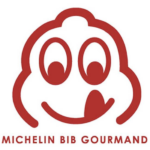JIN
Jin is the Japanese pronunciation of the character 仁. It means “benevolence” and finds its root in Confucian ideals. The character Jin consists of two elements. The left side represents a human being and the right side represents the numeral two. Jin is said to depict the way two people should treat one another. We, the founding partners, chose Jin as our ramen bar’s name not only out of an enthusiasm for ramen, but also from a desire to grow a business that has a positive impact on the community. In 2012, after Jin gains a solid foothold in the neighborhood, we hope that you, our customers, will advise us on how Jin should use its resources to benefit our community and neighbors.
OUR STYLE OF RAMEN
HAKATA RAMEN
Hakata is famous for its style of ramen, which has a very pungent smell thanks to a pork rib broth called tonkotsu (豚骨). Enjoy it with pickled ginger and lots of sesame seeds. Save the broth, because you can order a refill of kaedama (extra order of noodle). Fukuoka is also known for having good gyoza (pork dumplings) and there are many places to try some. (They are a perfect appetizer/side dish for ramen, incidentally.)
Hakata ramen is considered one of Japan’s top three styles of ramen (along with Tokyo and Sapporo). The ramen of northern Kyushu, more specifically, of Hakata and Kumamoto, are what originally put “Kyushu ramen” on the map. A long time ago, Hakata and Nagahama, two districts in Fukuoka city, each had distinct styles, but these days they’re virtually indistinguishable. Characteristally, Nagahama ramen is mellower in flavor and a touch less kotteri, with a soup that is bleach white in appearance and nori (roasted seaweed) as a topping.
Be it Hakata or Nagahama, ramen from Fukuoka features a soup made primarily with pork bones, which are cooked for a long time over extremely high heat. Such a method of cooking releases the bone marrow into the broth and gives the soup its characteristic richness. Flavors vary depending on cooking time and exactly which pieces of bone are used. Savory shoyu tare, or soy sauce soup base, is typically not added, although there are notable exceptions at shops which serve a soup pale brown in color. Often the tare is placed table-side for diners to season their broth to taste.
Noodles are distinct – firm in texture and ultra thin, straight and white in appearance. They are boiled very quickly. They are unrisen, made with a very low amount of sodium bicarbonate water. One origin story proclaims that they were initially devised for the “impatient Hakata child.” Portion size is typically small, but one of the unique and best-loved aspects of Hakata ramen is the “kaedama” system – where diners order extra servings of noodles for a marginal cost.
Toppings popular with Hakata ramen are chashu, kikurage (wood-ear mushroom), and negi (green onions)of the smaller, deeper green variety. Most striking of all is the use of benishoga (pickled red ginger), known to the Western world as “that red stuff you put on Yoshinoya beef bowls”, as an optional tableside garnish. Crushed or whole roasted sesame seeds, and karashi takana (spicy pickled mustard greens) are also prevalent. Kyushu ramen shops often use garlic as a flavoring. In the Hakata style, crushed garlic is added to taste by the diner (often DIY style with a tableside garlic press).


